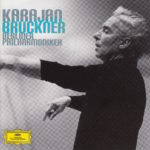 My “office” first thing this morning – the restaurant near my actual office.
My “office” first thing this morning – the restaurant near my actual office.
Sometimes, I really enjoy just being out and about, having coffee (or, as is the case this morning, Greek Gods yogurt – Black Cherry flavor – and Smart Water), watching people, listening to Bruckner, and typing these words.
My favorite thing to do every morning, is get up at 5:01 or 5:31 (I like arising at an odd time like that), and get to a restaurant by 6am when it first opens. I enjoy the bright lights, the coffee, the people to see and hear. If I am not up and sitting in a restaurant writing by 6am I consider my day over, and my time wasted.
So…
Here I am.
 This morning’s conductor of Anton Bruckner’s Symphony No. 5 in B-Flat Major (WAB 105) – nicknamed “Tragic,” “Church of Faith,” or “Pizzicato” symphony (for reasons I’m still discovering), is Austrian Herbert von Karajan (1908-1989), one of the most highly respected conductors – and interpreters of Anton Bruckner’s music – who ever lived.
This morning’s conductor of Anton Bruckner’s Symphony No. 5 in B-Flat Major (WAB 105) – nicknamed “Tragic,” “Church of Faith,” or “Pizzicato” symphony (for reasons I’m still discovering), is Austrian Herbert von Karajan (1908-1989), one of the most highly respected conductors – and interpreters of Anton Bruckner’s music – who ever lived.
In fact, I compared Maestro Karajan to Tolkien’s fantasy novel Lord of the Rings on Day 56 and wrote that if Tolkien had written about the conducting world, Karajan would be the “one ring to rule them all.”
I first encountered the Maestro on Day 8 of my 144-day journey. On that day, he was interpreting Bruckner’s First Symphony.
Then, on Day 24, Symphony No. 2
Then, Day 40, Symphony No. 3.
And, most recently, on the aforementioned Day 56, Symphony No. 4.
 Before I write another word – and totally not in keeping with my guideline to put the objective aspect first, I have to ask WTF Deutsche Grammophon? Why did you split Symphony No. 5 onto two different CDs, with Movement I on CD 1 and movements II-IV on CD 2?
Before I write another word – and totally not in keeping with my guideline to put the objective aspect first, I have to ask WTF Deutsche Grammophon? Why did you split Symphony No. 5 onto two different CDs, with Movement I on CD 1 and movements II-IV on CD 2?
Wait a minute.
I know why.
This is the first recording in my exploration of Bruckner’s Fifth that tops 80 minutes! This is unequivocally a “Yikes!” recording. The capacity of the average CD is 80 minutes. Slightly less if one wants to avoid pushing it too far. So this recording, at 80:35, blows by the capacity of a single CD to hold the information; therefore, DG had to split it onto two discs.
That makes for a very choppy listening experience, let me assure you.
 For example, when the CDs are in a CD-changer, one has an interminable intermission between the first CD and the second one as the player cycles through to the next. Or, try changing a CD in the car while you’re cruising along at 70 miles an hour, and the second disc is in the case in the back seat. Or, if I grab one CD from home, thinking I’ll have all of Bruckner’s Fifth on it, only to find out when I get somewhere that I don’t, well…
For example, when the CDs are in a CD-changer, one has an interminable intermission between the first CD and the second one as the player cycles through to the next. Or, try changing a CD in the car while you’re cruising along at 70 miles an hour, and the second disc is in the case in the back seat. Or, if I grab one CD from home, thinking I’ll have all of Bruckner’s Fifth on it, only to find out when I get somewhere that I don’t, well…
Sadness.
Anyway, back to the Karajan recording this morning.
Bruckner’s Symphony No. 5 in B-Flat Major (WAB 105) composed in 1875-1876
Herbert von Karajan conducts
I have no idea which version Karajan chose; it’s not listed in the CD booklet/liner notes
Berliner Philharmoniker plays
The symphony clocks in at 80:35 (which makes it the first “Yikes!” recording of Bruckner’s Fifth)
This was recorded in Berlin, Germany, in December of 1976
Karajan was 68 when he conducted it
Bruckner was 51 when he finished composing it
This recording was released on the Deutsche Grammophon label
Bruckner wrote his symphonies in four parts. The time breakdown of this one (Symphony No. 5 in B Flat Major, version unknown), from this particular conductor (Karajan) and this particular orchestra (Berliner Philharmoniker) is as follows:
I. Introduction (Adagio) — Allegro. B-flat major……………………………20:43
II. Adagio. Sehr langsam. (Very slowly) D minor……………………………21:26
III. Scherzo. Molto vivace D minor…………………………………………………13:44
IV. Finale (Adagio) — Allegro moderato. B-flat major…………………..24:42
Total running time: 80:35
And now for my subjective assessment:
My Rating:
Recording quality: 5
Overall musicianship: 5
CD liner notes: 5 (lengthy and informative, but very heavy on the Karajan worship)
How does this make me feel: 5
From the opening low notes of Movement I, I was held spellbound.
Anyone who says all symphonies sound the same hasn’t a clue how different they are.
Yesterday, I was almost put to sleep by Jochum’s interpretation of Bruckner’s Fifth.
Today, I am totally diggin’ Karajan’s interpretation.
It has to do with the sound engineering, I think. At least 50% of it. If the sound is rich and full, if the instruments are warm and not brassy, if there’s “air” between the instruments so that each can be heard clearly, and if the tempo is brisk…
…then something “pops.”
It’s magic time.
This was a masterful recording and interpretation, from first notes of Movement I to the big finish of the Finale (Movement IV).
“Huzzah!”

Very pleased to see that Haitink and Karajan have persuaded you of B5’s mastery! I know the term ‘cathedrals of sound’ gets flung around a lot when discussing Bruckner’s symphonies, but I think it kind of fits with this one. Massive, labyrinthine, monumental… and somehow austere, fascinatingly so (to me at least).
Hi Steve,
Thank you for stopping by.
What I’ve discovered – in fact, with striking clarity – is how much difference an orchestra, a conductor, and a sound engineer makes in my enjoyment of a symphony.
Bruckner’s Fifth, for example, in the right hands, becomes a thing of beauty. In the wrong hands it’s alternately a snooze-fest or else it grates on me like fingernails on a chalkboard.
When I listen to Haitink or Karajan or Barenboim, I actually enjoy the Fifth.
However, when I listen to Maazel, Paternostro, even Jochum from the “white box” (DG label), I am put off. And I know which one it will be (heaven or hell) within the first two minutes.
It has to do with how “brassy” the horns sound to me. If they’re mic’ed too loudly, they become harsh and piercing. Even a French horn, usually one of the mellowest of instruments, can become a weapon of mass destruction to my ears if it’s not played by a master and recorded by a sound engineer who understands what could happen to a brass instrument if it’s not recorded properly.
“Cathedral of Sound” is a wonderful descriptor. That’s likely what attracted me to Bruckner in the first place. There’s something visceral about his compositions that grabbed me from the get-go. The first time I heard a Bruckner piece I was hooked. It occupies that rare space between heart and head, for me. It hits me emotionally, but there’s also so much to it that my head can be engaged at the same time. Sort of like Progressive Rock for me, groups like ELP, Yes, early Genesis, King Crimson, early Rush, early Kansas, et al. Bands that create a soundscape in my head that I also feel in my heart are among my all-time favorites. I’ve been listening to music from those bands for over 40 years, and it never gets old to me.
Anyway, I’ve been giving Symphony No. 5 my best shot. It’s my least favorite so far. But I know how much my enjoyment of it depends on the aforementioned three main factors (orchestra, sound engineering, and conductor).
Again, thank you for leaving a comment. I appreciate your time and insight.
– Bill